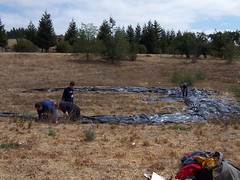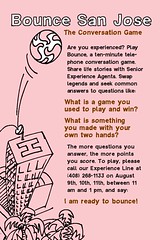Foo Camp this weekend was a happy, play-packed, geek-tacular affair.
Some highlights:
The wonderful Chris DiBona (my new superhero) arranged for a Google Earth/Maps flyover of the campgrounds on Saturday at noon. Several groups created ground installations to be captured at a 3in/pixel resolution; Chris and I headed up the most ambitious effort: to make a flat Cylon Raider replica, at 54 foot x 34 foot scale. We had an outstanding eight-person team working on the project, incuding Zack Exley, Dick Hardt, Artur Bergman, and Dawn Foster. We took a highly methodical approach to the design and installation, involving mapping an overhead photo of the raider onto a grid and then marking out 1 x 1 foot sections of the ground for pixel-by-pixel representation of the distinctive Battlestar Galactica icon. We raced to get everything in place before the plane flew over, and now soon, (in about a month), Google Earth and Maps images of the Sebastopol O'Reilly grounds will reveal that enemy spacecraft has crashed here on Earth! Ground photos of our work are here. However, it's the overflight photos that will be truly amazing.
Saturday night marked the return of the OOF! The Reverse FOO Scavenger Hunt, which I designed and deployed. How the hunt works: teams collect any ten objects they want. THEN they get the list, inspired by themes presented at FOO talks and roundtable sessions. Teams must "find" all of the items on the list in the collection of objects they've already assembled. All improvisational hacks and extraordinary demonstrations are encouraged. The winning team's members included the incredibly creative and gameful Cory Ondrejka, Liz Lawley, Quinn Norton, and Greg Stein, who respectively performed a literally mind-blowing brain hack with a bottle of whiskey, a sensational demo of sleeping-bag as virtual world interface, a hypnotic whiteboard recursion into the land of continuous partial attention, and a very convincing and moving portrait of the first man-pregnancy. The special guest judges for the event were danah boyd, who also helped me plan and stage the foo-tacular event, artur bergman and Nat Torkington. Together, they skillfully managed to bring to the game to a perfect tie among all teams, allowing me to run the special 60-second Death Defying Tiebreaker round. I was awed by the spirit of adventure with which some of the players (especially Paul Hammond) took "death defying" literally. And in general, I was inspired and humbled by all of the players' gutsy, creative participation. The complete rules and scavenger hunt list were as follows:
Please find the following objects:
1. A fully installed functional body modification (demo, please)
2. Spiritual computing object (demo, please)
3. A prop from the set of the 2042 Japanese remake of Snakes on a Plane (scene, please)
4. A viable alternate energy source (demo, please)
5. The new Third Life interface
6. When ThingLinks Go Wrong
7. Evidence of the most insidious viral marketing effort of the year 2007
8. The FOOFRACK™ Continuous Partial Attention Device
9. Proof that one of your team members is actually a Cylon, a Werewolf or a VC in disguise
10. A craft object from the BRAINS! Issue of Make Magazine (Vol. 13)
Rules:You have 60 minutes to “find” these objects.You can only use the 10 objects your team already has—no trading, no substitutions.You can hack and mod your objects any way you want.You cannot use an object to represent more than one item on the list.
Your success in finding these objects will be judged based on your live demonstrations and explanations. Prepare to be persuasive!In the case of a tie, teams will play a 60-second death-defying, single-object tiebreaker round.
On Sunday morning, I conducted a session with the super-sharp Amy Jo Kim about the social life of digital gaming. I gave a short talk exploring how supergaming can be used to open source public and shared spaces. I also had the chance throw a Massively Multiplayer Thumb Wrestling game by way of demonstrating the power of network-inspired grooming networks, always my favorite way to end a lecture.
Finally, Werewolf games from 10 PM until 5:30 AM on Friday and Saturday nights. Huzzah huzzah! At Foo Camp last year, I spent a lot of time trying to introduce certain modifications to the traditional folk version of the game. The most important to me was to change the game from "reveal" (a logic puzzle) to "no reveal" (a psychological and performace puzzle). I was thrilled this year that I didn't need to convince anyone--the change has stuck, and almost all of the games played were no reveal, which is the version I've been organizing with Artur for the past several months in preparation for the launch of our worldwide tournament Werewolf league. As usual, Werewolf masterminds Cal Henderson and Tom Coates were a joy to watch as they slaughtered their way through the village, under the skillful moderation of danah boyd. And through the late, late, late gameplay, I also got to know better some amazing people while watching their lynching and devouring skills grow exponentially! In particular, I was thoroughly impressed by Erik Benson's, Ramez Naam's, and Sam Ruby's Werewolfian prowess. Also, they are really thoughtful, well-spoken, fascinating people with really inspiring work, which somehow Werewolf provides a great platform for getting to know, in the midst of all those heated debates, defenses, and lynching.
As with last year, I found play at Foo an unbelievably effective way to connect with people in a really accelerated fashion. An adventurous ludic spirit is the single most important thing for me to find in future collaborators and conspirators, and running a variety of games is a great way to cut through the increasing morass of people who profess to be interested in games and game design, but who wouldn't deign to actually play one, in order to find the people who are sincerely ready to embrace and to explore ludic possibilities in an increasingly gameful network society. I was really happy to play with so many brilliant people this weekend and to learn about their vision for future technologies and software in the process. I hope to be invited back to FOOcamp next year, but in the meantime, look for me at O'Reilly conferences running evening Werewolf games!



